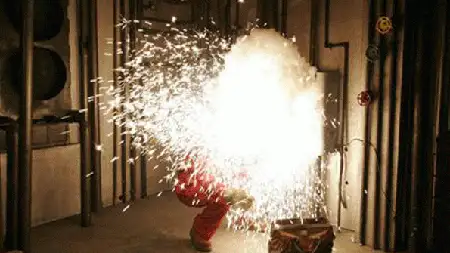Arc Blast Definition - Explosive Energy Explained
By Antony Parsons, P.E., Ph.D.

NFPA 70e Training
Our customized live online or in‑person group training can be delivered to your staff at your location.

- Live Online
- 6 hours Instructor-led
- Group Training Available
Download Our OSHA FS3529 Fact Sheet – Lockout/Tagout Safety Procedures

- Learn how to disable machines and isolate energy sources safely
- Follow OSHA guidelines for developing energy control programs
- Protect workers with proper lockout devices and annual inspections
An arc blast is a violent pressure wave caused by a high-energy arc fault. It releases intense force, heat, and sound, potentially hurling equipment and injuring workers. Arc blasts are serious electrical hazards that require PPE and risk assessments under NFPA 70E.
What is a good Arc Blast Definition?
✅ Sudden explosive pressure wave from an arc fault event
✅ Causes flying debris, hearing damage, and blunt-force injuries
✅ Requires PPE, arc flash labeling, and NFPA 70E compliance for safety
A good arc blast definition is: explosive energy like molten metal released during an arc flash explosion. Arc blast sends more than 2,000 North American electrical workers to burn centers each year. The sad thing is that most of these workers will not have been properly warned of the magnitude of the hazard, if they're warned at all. Despite all the efforts to train electrical workers about the potential hazards of arc blasts, there are still too many injuries and fatalities. Workers exposed to 480V systems face higher arc risks; learn more in our article on 480V arc flash hazards.
Arc Blast Injuries
Although arc blast injuries are not as frequent as other electrical injuries, their severity makes the costs to human life and to industry as a whole much, much greater. The dollar cost can easily exceed $1 million, and includes not only medical expenses, but the costs of equipment replacement, downtime and insurance.
Electrical injuries and fatalities from electrical arc blast incidents have been taking place ever since electric power was first generated and distributed. Arc-flash accidents that result in a serious injury or fatality occur five to 10 times a day in the United States. Recently, to improve workplace safety, the industry has begun to focus on the arc flash hazard that is present when workers must perform work on energized electrical equipment without wearing personal protective equipment ppe. Explore the causes of arc flash injuries and how they differ from blunt-force trauma sustained during an arc blast event.
Electricity Today T&D Magazine Subscribe for FREE

- Timely insights from industry experts
- Practical solutions T&D engineers
- Free access to every issue
NFPA 70e Development
One of the results of that focus has been the development and publication of NFPA 70E Standard for Electrical Safety in the Workplace. NFPA 70e is widely recognized as an industry-consensus electrical safety standard that defines the requirements for safely working on or around electrical equipment. OSHA now recognizes the NFPA 70e standard as a written, published standard, available to the industry, and they cite the requirements of this standard for employers under their general duty clause. A comprehensive arc flash risk assessment can determine incident energy levels and required safety precautions. To prevent serious injury, facilities should conduct a proper arc flash hazard analysis to assess risk levels and required PPE.
What causes arc blast?
Arc flash occurs when electrical workers are working "live", meaning that they are not de-energizing circuit breakers and other protective devices before working on them. A short circuit or fault occurs when the insulation between energized electrical phase conductors, or between a phase conductor and ground, is compromised. During a so-called “bolted” fault, the fault current flows over a conductive path. While such faults can be damaging, little energy is released into the surrounding environment during the fault. During an arcing fault, however, the fault current instead flows through the air rather than through a conductor or busbar and a great deal of thermal energy is released into the environment. This sudden release of thermal energy, similar to that seen in an electrical arc furnace, is referred to as an arc-flash event. The difference between arc flash vs arc blast is crucial—one burns, the other explodes, and both can be fatal.
The degree of arc blast hazard is measured by the available incident energy, expressed in calories or joules per square centimeter. This hazardous "incident energy" creates the thermal exposure that an electrical worker standing at a certain distance from the source of the arc (the “working distance”) would expect to receive on the head and torso. In addition to the thermal release, other hazards are produced by these events, including arc blast (a high-pressure wave), sound levels that can lead to permanent hearing damage, and often a ballistic threat from flying particles and objects.
Related Resources








